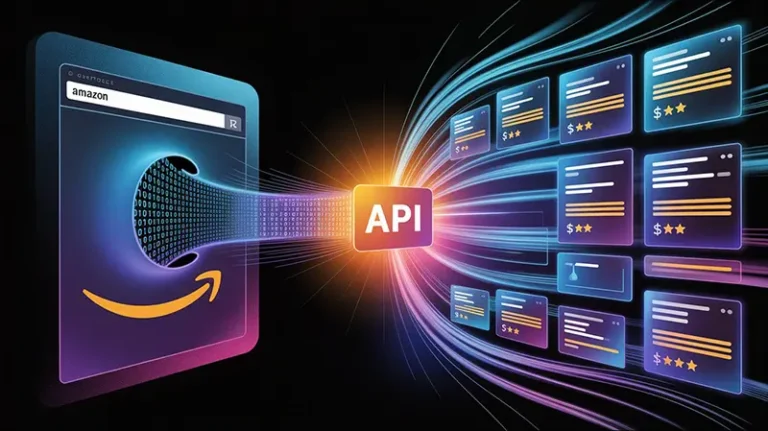Scrape API to extract Amazon product detail data|E-commerce Product Details API Extraction|Amazon Product Data Collection API|Amazon Product Information Scraping Tool|Amazon Data Crawler Interface Service
In the era of digital commerce, data is the core of competitiveness. For e-commerce professionals, obtaining accurate and timely Amazon product detail data is not only the foundation of market analysis but also the key to formulating pricing strategies and optimizing product assortments. This article will provide an in-depth exploration of how to use a Scrape API to achieve efficient Amazon product data collection, offering powerful data support for your e-commerce business.
Why Do You Need an Amazon Product Data Scraping API?
The Data-Driven Reality of E-commerce Competition
Modern e-commerce competition has shifted from simple price wars to a battle of data intelligence. Successful e-commerce companies share a common trait: they have a deep understanding of market dynamics and a precise grasp of consumer needs, all of which are derived from the analysis of vast amounts of product data.
When you search for “Amazon product data scraping API,” the underlying needs often include:
- Competitor Analysis: Understanding the pricing strategies, sales performance, and user reviews of similar products.
- Market Trend Insight: Grasping changes in best-selling products, new product launches, and price fluctuation patterns.
- Supply Chain Optimization: Analyzing the performance of products from different suppliers to optimize purchasing decisions.
- Marketing Strategy Formulation: Developing precise advertising and promotional activities based on data.
Limitations of Traditional Data Acquisition Methods
Many e-commerce professionals have tried to collect data manually or use simple scraping tools, but they quickly discover the drawbacks of these methods:
- Low Efficiency: Manual data collection is time-consuming and laborious, unable to meet the demands of large-scale data needs.
- Inaccurate Data: Changes in page structure lead to data parsing failures.
- Legal Risks: Unregulated data collection may cross legal boundaries.
- Technical Barriers: Building and maintaining a custom scraping system requires a professional technical team.
Scrape API: A Professional Solution for Amazon Data Scraping
Overview of Product Advantages
As a professional e-commerce data collection tool, the Scrape API offers the following core advantages:
- Intelligent Adaptability: The system can dynamically adapt to changes in the structure of various e-commerce pages like Amazon, automatically identifying and extracting relevant product data through intelligent recognition algorithms.
- Rich Data Fields: It supports the extraction of over 30 data fields, including ASIN, title, price, star rating, review count, images, sales volume, seller information, and more.
- Multi-Site Support: It not only supports Amazon but also covers other major e-commerce platforms like Walmart, Shopify, Shopee, and eBay.
- Flexible Invocation Methods: It provides both synchronous and asynchronous API call modes to meet the needs of different business scenarios.
Supported Data Scraping Scenarios
1. Product Detail Data Collection
This is the most frequently used function, capable of obtaining complete information from an Amazon product page:
JSON
{
"asin": "B0DYTF8L2W",
"title": "Product Title",
"price": "$29.99",
"star": "4.5",
"rating": "1,234",
"image": "https://image-url.jpg",
"seller": "Seller Name",
"brand": "Brand Name",
"description": "Product description content",
"category_id": "Category ID",
"first_date": "Date First Available"
}
2. Keyword Search Result Collection
Obtain a list of relevant products through a keyword search, suitable for market research and competitor analysis:
- Acquire all product information from the search results page.
- Support data collection for different sorting methods.
- Allows filtering by price range, rating, and other criteria.
3. List & Ranking Data Collection
Collect data from various Amazon lists and charts:
- Best Sellers: Understand the current hot products in the market.
- New Releases: Keep track of new product launch dynamics5.
- Category Rankings: Analyze the competitive landscape of specific categories.
4. Seller Storefront Data Collection
Obtain all product information from a specific seller:
- Analyze the product layout of competitors.
- Monitor price changes of key sellers.
- Evaluate the strength of potential partners.
Practical Tutorial: How to Scrape Amazon Product Details with the Scrape API
Step 1: API Authentication Configuration
First, you need to obtain an API access token:
Bash
curl -X POST http://scrapeapi.pangolinfo.com/api/v1/auth \
-H 'Content-Type: application/json' \
-d '{"email": "[email protected]", "password": "your-password"}'
After successful authentication, the system will return an access token:
JSON
{
"code": 0,
"subCode": null,
"message": "ok",
"data": "your-access-token"
}
Step 2: Constructing the Product Detail Scraping Request
Taking the collection of Amazon product details as an example, construct the complete API request:
Bash
curl -X POST http://scrapeapi.pangolinfo.com/api/v1 \
-H 'Content-Type: application/json' \
-H 'Authorization: Bearer your-access-token' \
-d '{
"url": "https://www.amazon.com/dp/B0DYTF8L2W",
"parserName": "amzProductDetail",
"formats": ["json"],
"bizContext": {
"zipcode": "10041"
}
}'
Step 3: Parsing the Returned Data
The API will return structured product data:
JSON
{
"code": 0,
"subCode": null,
"message": "ok",
"data": {
"json": [
{
"asin": "B0DYTF8L2W",
"title": "Premium Wireless Headphones",
"price": "$79.99",
"star": "4.3",
"rating": "2,847",
"image": "https://m.media-amazon.com/images/I/61abc123.jpg",
"seller": "TechBrand Official",
"brand": "TechBrand",
"has_cart": true,
"description": "High-quality wireless headphones...",
"deliveryTime": "2-3 business days",
"coupon": "Save 10% with code SAVE10"
}
]
}
}
9
Step 4: Batch Data Processing
For large-scale data collection needs, you can use the batch interface:
Bash
curl -X POST http://scrapeapi.pangolinfo.com/api/v1/batch \
-H 'Content-Type: application/json' \
-H 'Authorization: Bearer your-access-token' \
-d '{
"urls": [
"https://www.amazon.com/dp/B0DYTF8L2W",
"https://www.amazon.com/dp/B0DYTF8L3X",
"https://www.amazon.com/dp/B0DYTF8L4Y"
],
"formats": ["markdown"]
}'
10101010
In-Depth Analysis of Advanced Features
Geo-Targeted Scraping
Amazon’s product information, such as price, inventory status, and delivery details, can vary based on the user’s geographical location. The Scrape API supports customized geo-targeted scraping through a zip code parameter11.
Supported countries and zip codes12:
- USA: “10041”, “90001”, “60601”, “84104”
- UK: “W1S 3AS”, “EH15 1LR”, “M13 9PL”, “M2 5BQ”
- France: “75000”, “69001”, “06000”, “13000”
- Germany: “80331”, “10115”, “20095”, “60306”
This feature is particularly important for cross-border e-commerce businesses, as it helps you:
- Understand price differences in various markets.
- Analyze regional supply chain efficiency.
- Develop targeted marketing strategies.
Asynchronous Processing Mechanism
For large-scale data collection tasks, synchronous requests might face timeout issues. The Scrape API provides an asynchronous processing mechanism17:
Bash
curl -X POST https://extapi.pangolinfo.com/api/v1 \
-H 'Content-Type: application/json' \
-H 'Authorization: Bearer your-access-token' \
-d '{
"url": "https://www.amazon.com/dp/B0DYTF8L2W",
"callbackUrl": "https://your-server.com/callback",
"bizKey": "amzProduct",
"zipcode": "10041"
}'
Advantages of the asynchronous mode:
- Supports large-volume data processing.
- Avoids request timeout problems.
- Improves system stability.
- Supports task status tracking.
Multi-Format Data Output
The Scrape API supports multiple data output formats to meet different business needs19191919:
- JSON format: Suitable for programmatic processing and data analysis20.
- Markdown format: Convenient for documentation and content creation21.
- Raw HTML: Retains complete page information for in-depth analysis22.
Practical Application Case Studies
Case 1: E-commerce Product Selection Data Analysis
A cross-border e-commerce company needed to analyze the 3C electronics market and built a complete data collection system using the Scrape API.
Collection Strategy:
- Keyword Searches: Targeted keywords like “wireless headphones” and “bluetooth speakers.”
- List Monitoring: Collected the top 100 best-sellers in the Electronics category daily.
- Competitor Tracking: Locked onto 20 key competitors to monitor their product price changes.
Data Processing Workflow:
Python
import requests
import json
def collect_product_data(keyword, zipcode="10041"):
"""Collects product data related to a keyword."""
url = "http://scrapeapi.pangolinfo.com/api/v1"
headers = {
"Content-Type": "application/json",
"Authorization": "Bearer your-token"
}
payload = {
"url": f"https://www.amazon.com/s?k={keyword}",
"parserName": "amzKeyword",
"formats": ["json"],
"bizContext": {"zipcode": zipcode}
}
response = requests.post(url, headers=headers, json=payload)
return response.json()
# Collect data
products = collect_product_data("wireless headphones")
Business Outcomes:
- Identified 15 high-potential product opportunities.
- Developed a precise pricing strategy.
- Achieved a 45% increase in quarterly sales.
Case 2: Price Monitoring System
A brand owner needed to monitor the price compliance of its distributors and established an automated monitoring system using the Scrape API.
Monitoring Dimensions:
- Whether product prices comply with the brand’s suggested retail price.
- Whether promotional activities are authorized.
- Inventory status and delivery timeliness.
Technical Implementation:
Python
from datetime import datetime
def monitor_pricing(asin_list):
"""Monitors product prices in batch."""
results = []
for asin in asin_list:
product_url = f"https://www.amazon.com/dp/{asin}"
# Assuming collect_product_detail is a function that calls the API
data = collect_product_detail(product_url)
if data['code'] == 0:
product_info = data['data']['json'][0]
results.append({
'asin': asin,
'current_price': product_info.get('price'),
'seller': product_info.get('seller'),
'timestamp': datetime.now()
})
return results
System Effects:
- Automatically detected and addressed 95% of pricing violations.
- Improved the stability of the brand’s pricing system by 60%.
- Increased channel management efficiency by 3x.
Case 3: Market Trend Analysis
A data analytics firm provides e-commerce market trend reports to its clients and built a comprehensive data collection system using the Scrape API.
Data Collection Scope:
- List and ranking data from 50 major product categories.
- Search results for 1,000 keywords.
- New product launch information from key brands.
Analysis Framework:
- Trend Identification: Used time-series analysis to discover market trends.
- Seasonality Analysis: Identified seasonal patterns in product sales.
- Competitive Landscape: Analyzed changes in market share and new entrants.
Key Findings:
- The growth rate of smart home products reached 300%.
- Eco-friendly concept products gained consumer favor.
- Livestreaming commerce had a significant impact on product sales.
Technical Architecture and Performance Optimization
Distributed Scraping Architecture
To handle large-scale data collection demands, a distributed architecture is recommended:
Python
from concurrent.futures import ThreadPoolExecutor
import time
class AmazonDataCollector:
def __init__(self, api_token, max_workers=10):
self.api_token = api_token
self.max_workers = max_workers
self.base_url = "http://scrapeapi.pangolinfo.com/api/v1"
def collect_batch(self, url_list):
"""Collects data in batch."""
with ThreadPoolExecutor(max_workers=self.max_workers) as executor:
futures = [
executor.submit(self._collect_single, url)
for url in url_list
]
results = []
for future in futures:
try:
result = future.result(timeout=30)
results.append(result)
except Exception as e:
print(f"Scraping failed: {e}")
return results
def _collect_single(self, url):
"""Collects data for a single URL."""
# Implement the specific collection logic here
pass
Data Quality Assurance
In large-scale data collection, data quality is a critical consideration.
Data Validation Rules:
- Price Reasonableness Check: Filter out abnormal price data.
- Image URL Validity Check: Ensure image links are accessible.
- Rating Data Consistency: Verify that the star rating matches the review count.
Exception Handling Mechanism:
Python
def validate_product_data(product_data):
"""Validates the quality of product data."""
errors = []
# Price validation
if not product_data.get('price') or product_data.get('price') == 'N/A':
errors.append("Missing price information")
# ASIN validation
if not product_data.get('asin') or len(product_data.get('asin')) != 10:
errors.append("Incorrect ASIN format")
# Rating validation
try:
rating = float(product_data.get('star', 0))
if rating < 0 or rating > 5:
errors.append("Anomalous rating data")
except (ValueError, TypeError):
errors.append("Incorrect rating format")
return len(errors) == 0, errors
Performance Optimization Strategies
- Caching Mechanism:
- Implement caching for data that changes infrequently (e.g., basic product information).
- Use caching systems like Redis to improve response speed.
- Request Frequency Control:
- Implement intelligent request rate limiting to avoid triggering anti-scraping mechanisms.
- Adjust request intervals based on the target website’s access patterns.
- Data Compression:
- Use compression algorithms for large data transfers to reduce network overhead.
- Implement incremental data update mechanisms.
Data Compliance and Legal Considerations
Legal Boundaries of Data Scraping
When conducting Amazon product data scraping, it is imperative to strictly adhere to relevant laws and regulations.
Basic Principles:
- Public Data Principle: Only collect publicly accessible data.
- Reasonable Use Principle: The frequency and scale of data collection should be reasonable.
- Copyright Protection Principle: Respect the website’s copyright and intellectual property rights.
Compliance Measures:
- Adhere to the
robots.txtfile regulations. - Control request frequency and concurrency.
- Do not collect users’ personal privacy information.
- Establish a data usage audit mechanism.
Data Security Protection
- Data Transmission Security:
- Use HTTPS for data transmission.
- Implement API key management mechanisms.
- Regularly update access credentials.
- Data Storage Security:
- Encrypt sensitive data during storage.
- Implement access permission controls.
- Establish data backup mechanisms.
Business Value and ROI Analysis
Direct Economic Benefits
Using a Scrape API for Amazon product data collection can bring significant direct economic benefits:
- Cost Savings:
- Reduce manual data collection costs by over 80%.
- Avoid the development and maintenance costs of an in-house technical team.
- Increase data collection efficiency by more than 10x.
- Revenue Growth:
- Increase sales through precise product selection based on data insights.
- Improve profit margins by optimizing pricing strategies.
- Seize market opportunities by discovering them in a timely manner.
Indirect Strategic Value
- Decision Support:
- Provide data support for high-level decision-making.
- Reduce decision-making risks and uncertainties.
- Improve the accuracy of strategic planning.
- Competitive Advantage:
- Build a core competency driven by data.
- Establish an industry data barrier.
- Enhance the organization’s data maturity.
Future Development Trends
AI-Driven Intelligent Analysis
With the advancement of artificial intelligence, data collection will become more intelligent:
- Predictive Analytics:
- Predict product price trends based on historical data.
- Identify potential blockbuster products.
- Forecast changes in market demand.
- Personalized Recommendations:
- Provide personalized product recommendations based on user behavior data.
- Optimize product portfolio strategies.
- Enhance user experience and conversion rates.
Multi-Platform Data Integration
Future data collection will focus more on integrating multiple platforms:
- Omni-Channel Perspective:
- Integrate data from multiple platforms like Amazon, eBay, and Walmart.
- Build a comprehensive view of the market’s competitive landscape.
- Enable cross-platform data comparison and analysis.
- Data Standardization:
- Establish unified data standards and formats.
- Achieve seamless integration of data from different platforms.
- Improve the accuracy and efficiency of data analysis.
Best Practices and Recommendations
Data Scraping Strategy
- Define Clear Collection Goals:
- Clarify business needs and data use cases.
- Determine Key Performance Indicators (KPIs).
- Establish data quality standards.
- Choose an Appropriate Collection Frequency:
- Determine the collection cycle based on how frequently the data changes.
- Balance data timeliness with system load.
- Implement an intelligent scheduling mechanism.
- Establish a Monitoring and Alerting System:
- Monitor the execution status of collection tasks.
- Set up rules for exception alerts.
- Establish a rapid response mechanism for failures.
Data Processing Workflow
- Data Cleaning and Validation:
- Remove duplicate and invalid data.
- Standardize data formats.
- Verify data integrity and accuracy.
- Data Storage and Management:
- Choose a suitable storage solution.
- Establish data version management.
- Implement data lifecycle management.
- Data Analysis and Application:
- Build data analysis models.
- Develop data visualization tools.
- Establish a data-driven decision-making process.
Team Building and Training
- Skill Requirements:
- Ability to call APIs and process data.
- Skills in data analysis and visualization.
- Understanding of the e-commerce business.
- Training Content:
- How to use the Scrape API.
- Data analysis tools and techniques.
- Best practices for e-commerce data analysis.
Conclusion
In the grand trend of digital transformation, the collection and analysis of Amazon product detail data have become indispensable core capabilities for e-commerce enterprises. Through professional tools like the Scrape API, businesses can efficiently and accurately obtain massive amounts of product data, providing powerful support for business decisions.
From a technical perspective, the Scrape API not only solves the pain points of traditional data collection methods but also offers a flexible, stable, and efficient solution. From a business perspective, data-driven decision-making can significantly enhance a company’s competitiveness and profitability.
In the future, with the further development of AI technology and the increasing complexity of the e-commerce market, the importance of data collection and analysis will become even more prominent. Businesses that can establish a data advantage early on will be well-positioned to succeed in the fierce market competition.
Start your data-driven journey today! Visit www.pangolinfo.com, experience the powerful features of the Scrape API, and let data be the catalyst for your business success. In this era where data is king, the first movers will surely reap the greatest rewards.



